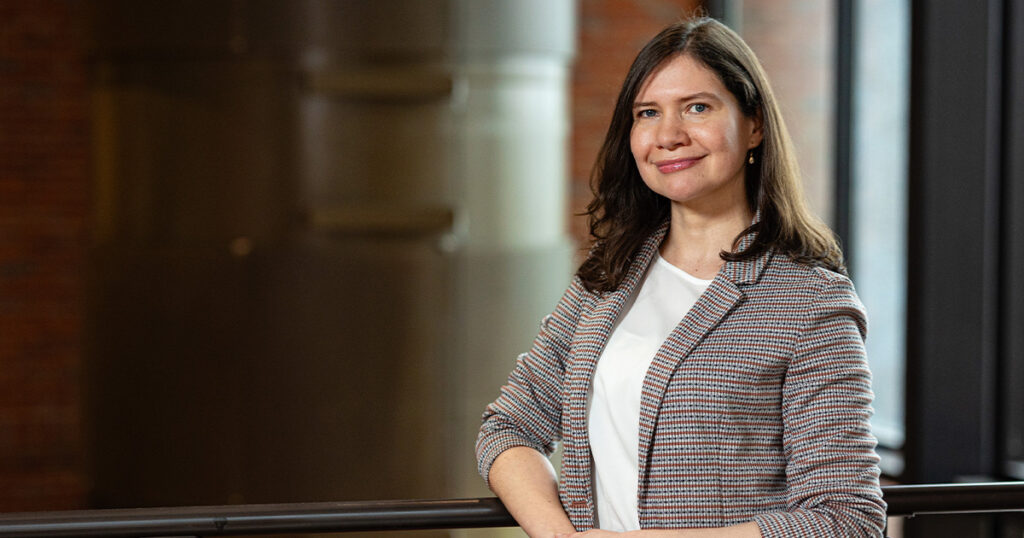Technology has made receiving items at home easier than ever.
If you need laundry detergent from the store, you can have it delivered instantaneously. If you see a pair of shoes you want to wear this week, they can arrive within two days. If you don’t feel like cooking one night, you can order a meal through Uber Eats to have at your doorstep right after work.
Unfortunately, the convenience comes with a cost beyond just the charge on a credit card. More deliveries mean more vehicles on the road, more traffic, more emissions, more noise, and more pavement damage, among other drawbacks.
Oriana Calderón, an assistant professor in the Department of Civil and Environmental Engineering, is working to help find solutions to some of these problems. Calderón’s expertise is freight transportation, particularly freight resiliency and sustainable freight transportation.
“Many of the freight researchers focus on the supply. Supply is the infrastructure, so let’s make more highways, more bridges, etc. They don’t consider the demand, which is very important as well,” Calderón said. “The demand is a very strong short-term initiative compared to the supply strategies.”
Necessary Decarbonization Strategies
Calderón’s research focuses on the movement of goods and services. Her interest in freight came while she was studying in her home country of Colombia and saw how much truck congestion impacted daily life while driving a car to work.
Calderón earned bachelor’s degrees in industrial engineering and economics from Universidad del Valle, and her Master of Business Administration (MBA) from Universidad ICESI. She obtained her PhD in transportation engineering in 2023 from Rensselaer Polytechnic Institute (RPI).
Given the increase in expedited deliveries that can be made with a simple click on an app, Calderón’s research in freight decarbonization is particularly timely. She is studying four main initiatives to help find solutions to alleviate problems like increased emissions and congestion:
- How to induce changes in the delivery time: “For example, instead of delivering during day hours, how can people receive orders at night. Because at night, there is less traffic.”
- How to alter delivery location: “The delivery lockers they put in shopping malls helps to consolidate the orders, and consolidating orders is equal to a smaller number of trips.”
- Changing the frequency of orders: “Nowadays, everyone wants to order small things every day. But if they consolidated the order to once a week or once a month, it would mean less trips.”
- Changing the delivery mode: “E-bikes, electric trucks, green technology vehicles, or delivery robots are more sustainable and better for the environment.”
“These are all initiatives that aim to change the behavior of users,” Calderón said. “Commercial establishments like businesses and shopping malls are all freight users. But nowadays, households like us, we are also freight users because of e-commerce.”
The next step is finding out what type of monetary or non-monetary incentives can be given to help change behavior, such as consumers consolidating orders for a discount or companies improving their public image by going greener.
“These types of strategies are the ones that potentially will be one of my main research focuses in this spring,” Calderón said. “I am working on a survey to understand the behavior of households when they order groceries in. I want to examine what is the most effective incentive that will change their behavior.”
Finding Trusted Change Agents
Calderón was a keynote speaker and presenter at four different symposiums and webinars in Latin America last fall. She recently had four papers published, including “Willingness to Limit ‘Panic Buying’ Purchases during the Covid-19 Pandemic in the U.S.”
The research in the paper sought to quantify the potential to mitigate panic buying during a national crisis through appeals from “trusted change agents” (TCAs), which are agents involved in disaster response efforts, such as government officials, first responders, and media members.
The data found that firefighters, followed by emergency responders and health officials, were the top three most trusted agents in the US when it came to taking advice about limiting purchases during disasters like pandemics, hurricanes, and fires.
“I have been working a lot on humanitarian logistics and how to improve the resiliency of freight when disasters occur,” said Calderón, who was quoted in the New York Times last October in the aftermath of Hurricane Helene. “All of these disruptions are disrupting the freight activity, so how can we make this freight activity more resilient when we have these disasters?”
As countries across the world continue to be impacted by crises, Calderón’s research will be essential to help keep freight moving and reaching people who need it most.
“One of my strategies is to look for freight demand management initiatives,” Calderón said. “How can users control purchases of essential supplies, and how can we improve how they are making these decisions in order to improve the availability of essential supplies for everyone, especially for vulnerable populations.”
Contact
Rhiannon Potkey (865-974-0683, rpotkey@utk.edu)
